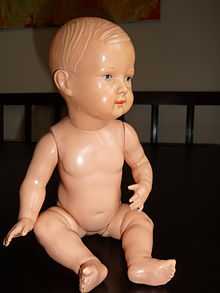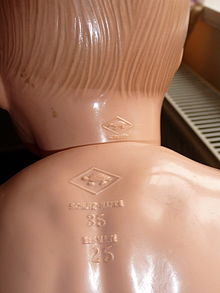turtle
The Turtle dolls and toys GmbH with the present headquarters in Rauenstein / Thuringia is the oldest doll manufacturer producing from 1896 to today throughout dolls.
Company history
In 1873 Viktor Lenel and his brother Alfred founded the "Rheinische Hartgummi-Waaren-Fabrik" with the businessman Friedrich Julius Bensinger (1841–1891) and the Hohenemser & Sons bank in Mannheim, which has been producing soft rubber since 1884 and celluloid since 1886 .
On March 27, 1885, the factory in Neckarau was destroyed by fire. After the reconstruction, which took place from April 1 to December 31, 1885, it traded under the name "Rheinische Gummi- und Celluloidfabrik".
As early as 1888, Adolf Bensinger , the oldest son of the company founder, joined the company's board of directors. Friedrich Julius Bensinger died in the summer of 1891. His second son, Carl Bensinger , also joined the company in April 1893 as a board member.
In 1898, the company premises had an area of 80,000 square meters. In addition to two canteens, a company health insurance fund and a coal fund were available to the employees as social facilities. In 1908-09, forty-eight company apartments were built according to plans by the architect Leopold Stober, spread over twelve two-story residential buildings. In 1900, 6,000 employees worked in around 150 buildings, in which 65 rolling mills and calenders, 105 presses and 170 comb cutting machines were operated. The annual raw celluloid production of around 4,500 tons corresponded to a third of the world production at that time. In 1910 the production of toy dolls in the Schwetzingen factory is stopped. Shortly after the outbreak of the First World War until its end, from January 1, 1915 to November 11, 1918, production was forcibly shut down.
The company was expropriated / Aryanized after 1933, but in 1929 it was already under the influence of IG Farben . The year 1929 marked the peak of celluloid production with an annual volume of 40,000 tons. Nevertheless, the plant was not spared from mass layoffs in the following years, especially in 1931/32. In 1939 toy production became a losing business. After the war damage had been repaired, it was rebuilt. As early as 1951, a production volume approaching the pre-war period was achieved.
Working with Käthe Kruse in 1954, an affordable doll made of tortulon, a plastic based on polypropylene that, unlike celluloid, is not so easily flammable, was developed. In 1965 the company name was changed to “Schildkröt AG, formerly Rheinische Gummi- und Celloloid-Fabrik”, ten years later, in 1975, doll production in Mannheim was discontinued.
On January 1, 1993, the headquarters were relocated to Rauenstein , near the traditional toy location Sonneberg . Since March 2014 the new owner is Stadlbauer GmbH from Puch near Salzburg.
Products
Initially, umbrella and stick handles were mainly produced, but also press combs and other toilet articles.
In 1896 the first doll, a waterproof "bath doll", was made from celluloid . The legal trademark, the “turtle”, was registered in the Imperial Patent Office in Berlin in 1899 and protected retrospectively from October 9, 1889. The “turtle” as the company logo should symbolize the new, robust material for toy dolls with its hard shell of the turtle. Celluloid as a material was a revolution in doll production, as it is break-proof, washable, colourfast and hygienic. Production using the blow-press method developed by Robert Zeller was revolutionary. In this way, doll heads and bodies, but also table tennis balls from celluloid could be produced inexpensively.
As early as 1940, Schildkröt-Puppen GmbH in Kaufbeuren produced booklets for the dolls. They contained child-friendly illustrations and verses, for example under the title: The turtle children in the zoo .
At the suggestion of French trading partners, Schildkröt also developed into a leading manufacturer of table tennis balls in Europe from 1887 . Today this product is manufactured almost exclusively in China and Japan. Schildkröt also made pewter molds from hard rubber with which fully plastic 40 mm figures (mainly German troops around 1900, but also French, Prussian and British soldiers from the Napoleonic Wars) can be cast. There were also casting accessories and matching vehicle kits. This production lasted until 1984.
In addition, from 1939 Igelit was processed , from 1955 the production of rigid PVC sheets "Rhenadur" for technical consumer goods and from 1956 the production of soft PVC films.
Today collector dolls and play dolls for children are produced in Rauenstein / Thuringia. About 20 employees work in Rauenstein who handcraft the dolls. There is a sample room and a small factory outlet that can be visited by anyone.
Current situation
Today Schildkröt produces limited editions of replicas in the classic collection . These dolls are second editions of old models. The most famous models are Bebi Bub, Hans, Bärbel, Ursel, Inge, Erika and Christel . Artist dolls are produced in small editions with high quality materials. The largest product line are the play dolls that are still manufactured at the Rauenstein site. The production and the sample room can be visited after registration. A small factory outlet is also available.
museum
The museum for turtle dolls has existed in Rauenstein since 2016.
literature
- Jürgen and Marianne Cieslik: The great Schildkröt book: Celluloid dolls from 1896 - 1956. 2nd revised edition. Cieslik, Duisburg 2004, ISBN 3-87463-378-0 .
- Roland Eisenlohr : The workers' settlement system of the city of Mannheim. Karlsruhe 1921.
- Christiane Fritsche: Looted, refunded and compensated. Aryanization and reparation in Mannheim. Publishing house Regionalkultur, Ubstadt-Weiher u. a. 2013, ISBN 978-3-89735-772-3 .
- Monika Ryll: The workers' housing estate in Mannheim. In: Mannheim and its buildings. Vol. 5, 2005, pp. 106-115.
Web links
Individual evidence
- ↑ Better an old doll? Readers ask. (No longer available online.) Öko-Test , June 2012, archived from the original on August 17, 2016 ; Retrieved July 9, 2016 . Info: The archive link was inserted automatically and has not yet been checked. Please check the original and archive link according to the instructions and then remove this notice.
- ↑ Stadlbauer News ( Memento of the original from June 17, 2015 in the Internet Archive ) Info: The archive link was inserted automatically and has not yet been checked. Please check the original and archive link according to the instructions and then remove this notice.
- ^ The Schildkröt children in the zoo, first edition 1940
- ^ Turtle doll museum in Rauenstein



